

1 Killing site(s)
Bronius M., born in 1919, recalls how he was requisitioned to dig the pits and bury the Jews: “Everybody from Ariogala was forced to dig the pits. All the neighbors had to do it. There were two pits dug for them. /…/ They came and took me from my home. /…/ I didn’t count, but there had to be more than one hundred diggers. There were so many of us. /…/ We dug until noon. They were shooting till the evening. It took them more than an hour. Then we went to fill in the pit. We assembled at our neighbor’s house and we saw how the Jews were led to the pit. We heard everything.” (Eyewitness N°129, interviewed in Uždubysys, on March 16-17, 2015).
“I escorted people to the shooting, guarded those who were taken to the shooting, forced to fill in the pits where the people who had been shot were thrown, and looted their property. /…/ For taking part in the shooting, I received two children’s coats, two fur coats, two pairs of shoes, a pair of boots, two feather pillows, three blankets, a man’s winter coat, a dress, a table, two chairs, a wardrobe, and a pull-out sofa.” [Deposition of alleged shooter Juozas K., taken on September 27, 1944, RG-22.002M.7021-94/421]
Ariogala is one of the oldest settlements in Lithuania and is mentioned in written sources as far back as the 13th century. During the 16th century, it grew into a small town and a market was set up in the town in the 17th century. Ariogala was destroyed by fire many times and during World War I, only about 30 houses were left after intensive battle in and around the town. The Jewish community in Ariogala was established in the 18th century. Even though Jews were a majority group in the local population (more than 1500 individuals), this number significantly decreased during the 19th century due to immigration to South Africa and the USA. Before World War II, only around 500 Jews lived in Ariogala. Jews made their living mostly from craftsmanship, trading and storekeeping. They owned a bank, a power station, a flourmill… The Jewish population was active in social and public life: there was a Jewish synagogue, a school, a drama club, a Jewish library, Zionist youth organizations and two competing movements of Social Zionists and Revisionists. Most Jewish businesses were nationalized, the school was closed and political organizations banned under Soviet rule, beginning in 1940.
One month after the German occupation in 1941 all the Jews from Ariogala and some nearby villages were gathered in the ghetto near the synagogue. They were guarded and taken for forced labor. At the end of August/beginning of September, local men from Ariogala and nearby areas were requisitioned to dig two pits near the Dubysa River. Later, all the Jews from the Ariogala ghetto were brought there. Before the execution, the Jews’ belongings were taken away from them and they were told to undress. Bronius M., who was requisitioned to dig the pit, remembers that the Jews “had to walk down to the pits about 100m from the place on the top of the hill where they had undressed.” Around 700 Jewish men, women and children were shot near Ariogala. A celebration was organized by those involved in the shooting after the execution.
Do you have additional information regarding a village that you would like to share with Yahad ?
Please contact us at contact@yahadinunum.org
or by calling Yahad – In Unum at +33 (0) 1 53 20 13 17